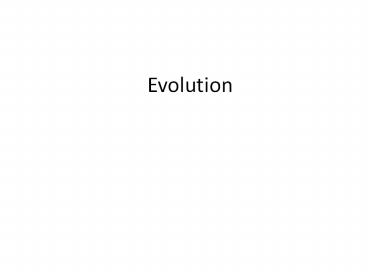Evolution - PowerPoint PPT Presentation
1 / 36
Title:
Evolution
Description:
Evolution Coevolution Transitional Species The Whale: How it has evolved Adaptations * Layers, distribution of fossils in layers-layers close together (organisms look ... – PowerPoint PPT presentation
Number of Views:234
Avg rating:3.0/5.0
Title: Evolution
1
Evolution
2
Biogenesis vs. Spontaneous Generation
- 1620s Redi-Italian Scientist set forth to prove
Spontaneous Generation WRONG! People did not
buy into itwhy?
3
Finally.Spontaneous Generation is Busted
- Pasteur-French 1820s
4
Life on Earth
Miller and Urey-1950s America
5
Fossils Interest in 1800s
6
Cuvier and Lyell- after studying rock layers,
came up with these conclusions
- George Cuvier-1800, Europe, since organisms in
rock layers spontaneously go extinct,
catastrophes must shape the way organisms evolve. - Charles Lyell-1850s-Europe, organisms change and
evolve from changing geological process that have
been around since the beginning of time. Slow,
steady changes, NOT sudden catastrophes have
shaped earth and its organisms. Idea of
uniformitarianism.
7
Lamarck-early 1800s
8
Charles Darwin 1850s
- Interested in science
- Read about Lyell's thoughts
- descent with modification-organisms came from a
common ancestor and was changed or modified with
time turning into a different organism - Sailed the Beagle to collect evidence of his
theory - Journal was made into a book called, the Origin
of Species
9
(No Transcript)
10
(No Transcript)
11
Set to prove his theory of Descent with
ModificationDarwins Journey on the Beagle
1830s
12
Galapagos Finches
13
Galapagos Turtles
14
Natural Selection with the White-Peppered Moths
1800s England
15
Natural Selection
- Caused descent with modification evolution
because of 4 main factors
16
4 factors
- Overproduction
- genetic variation
- struggle to survive
- differential reproduction
17
4 factors that lead to Natural Selection
- 1. Overproduction-better chance of survival with
the production of more offspring, because
eventually the environment will reach a carrying
capacity. - 2. Genetic Variation-different genes produce
different traits which may be more favorable in a
certain environment - 3. Struggle to Survive Organisms must compete
for survival, food, resources, space, genes
(adaptations). - 4. Differential Reproduction-Organisms with the
best adaptations are more likely to survive,
therefore they evolve
18
Thomas Malthus
- Late 1700s-Proposed that populations increase
faster than food supplies. Thus, populations are
always limited by conditions such as war,
disease, lack of food. - What does this mean for the human population?
Have we reached our carrying capacity? Do we
have any of these factors limiting our population
today?
19
(No Transcript)
20
- http//www.worldometers.info/world-population/
21
Evidence of Evolution
- Fossils-age and distribution
- Transitional Species
- Biogeography
- Anatomy-homologous structures
- Embryology
- Biological Molecules
22
Fossils in close proximity are alike, fossils far
away are different
23
Transitional species
24
Biogeography
- Study of the locations of organisms around the
world - Marsupials are only in Australia, however, they
look like moles, wolves, catsthey must have
evolved separately
25
AnatomyHomologous structures-shows a relationship
26
Anatomy Analogous structures do not show a
relationship
27
Embryology
28
Vestigial Structures
29
Biomolecules such as DNA
30
Phylogeny
31
Evolution in action
- Adaptive radiation-A new population to a new
environment, changing rapidly to adapt to its new
surroundings (CA Salamander) - Convergent evolution-different species evolve
similar traits to best suit its environment
(whale, dolphin and shark are unrelated but share
similar characteristics) - Divergent evolution-when descendents from a
common ancestor diversify into different species
that fit a different environment.
32
CA Salamander
33
Selective breeding
34
Coevolution
35
Transitional Species
The Whale How it has evolved
36
Adaptations































